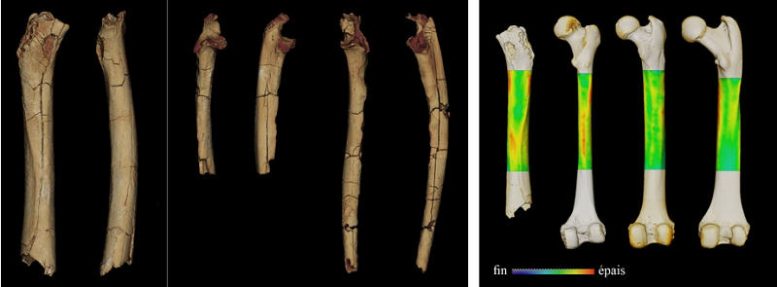The evolution of bipedalism is one of the major hallmarks in the evolution of human ancestors, The oldest bipedal ancestor found so far is 7 million years old,
https://scitechdaily.com/7-million-...e-oldest-representative-of-humanity-revealed/
A new study reveals that Sahelanthropus tchadensis, the oldest representative species of humanity, was bipedal.
It is believed that the development of bipedalism was a turning point in human evolution. However, there is disagreement over its modalities and age, notably due to the fact there are no fossilized remains. Researchers from the University of Poitiers, the French National Centre for Scientific Research (CNRS), and its Chadian partners analyzed three limb bones from Sahelanthropus tchadensis, the earliest known representative of the human genus. The study, which was recently published in the journal Nature, supports the hypothesis that bipedalism was developed extremely early in human history, at a time still associated with the ability to move on four limbs in trees.
Collection working session between Franck Guy (left) and Guillaume Daver (right), at the PALEVOPRIM laboratory, Poitiers (CNRS/University of Poitiers). Credit: Franck Guy / PALEVOPRIM / CNRS – University of Poitiers.
Sahelanthropus tchadensis is considered the earliest representative species of humans, dating back 7 million years. Its description goes back to 2001 when the Franco-Chadian Paleoanthropological Mission (MPFT) uncovered the bones of three people at Toros-Menalla in the Djurab Desert (Chad), including a particularly well-preserved cranium. This cranium, particularly the orientation and anterior location of the occipital foramen where the spinal column is inserted, reveals a form of locomotion on two legs, implying that it was capable of bipedalism.
In addition to the cranium, nicknamed Toumaï, and fragments of jaws and teeth that have already been published, the locality of Toros-Menalla 266 (TM 266) yielded two ulnae (forearm bone) and a femur (thigh bone). These bones were also attributed to Sahelanthropus because no other large primate was found at the site; however, it is impossible to know if they belong to the same individual as the cranium. Paleontologists from the University of Poitiers, the CNRS, the University of N’Djamena, and the National Centre of Research for Development (CNRD, Chad) recently published their complete analysis in Nature.

Left: 3D models of the postcranial material of Sahelanthropus tchadensis. From left to right: the femur, in posterior and medial view; the right and left ulnae, in anterior and lateral view. Right: Example of analysis performed to interpret the locomotor mode of Sahelanthropus tchadensis. 3D cortical thickness variation map for the femurs of (from left to right) Sahelanthropus, an extant human, a chimpanzee, and a gorilla (in posterior view). This analysis enables us to understand the variations of mechanical constraints on the femur and to interpret these constraints in terms of locomotor mode. Credit: Franck Guy / PALEVOPRIM / CNRS – University of Poitiers
https://scitechdaily.com/7-million-...e-oldest-representative-of-humanity-revealed/
A new study reveals that Sahelanthropus tchadensis, the oldest representative species of humanity, was bipedal.
It is believed that the development of bipedalism was a turning point in human evolution. However, there is disagreement over its modalities and age, notably due to the fact there are no fossilized remains. Researchers from the University of Poitiers, the French National Centre for Scientific Research (CNRS), and its Chadian partners analyzed three limb bones from Sahelanthropus tchadensis, the earliest known representative of the human genus. The study, which was recently published in the journal Nature, supports the hypothesis that bipedalism was developed extremely early in human history, at a time still associated with the ability to move on four limbs in trees.
Collection working session between Franck Guy (left) and Guillaume Daver (right), at the PALEVOPRIM laboratory, Poitiers (CNRS/University of Poitiers). Credit: Franck Guy / PALEVOPRIM / CNRS – University of Poitiers.
Sahelanthropus tchadensis is considered the earliest representative species of humans, dating back 7 million years. Its description goes back to 2001 when the Franco-Chadian Paleoanthropological Mission (MPFT) uncovered the bones of three people at Toros-Menalla in the Djurab Desert (Chad), including a particularly well-preserved cranium. This cranium, particularly the orientation and anterior location of the occipital foramen where the spinal column is inserted, reveals a form of locomotion on two legs, implying that it was capable of bipedalism.
In addition to the cranium, nicknamed Toumaï, and fragments of jaws and teeth that have already been published, the locality of Toros-Menalla 266 (TM 266) yielded two ulnae (forearm bone) and a femur (thigh bone). These bones were also attributed to Sahelanthropus because no other large primate was found at the site; however, it is impossible to know if they belong to the same individual as the cranium. Paleontologists from the University of Poitiers, the CNRS, the University of N’Djamena, and the National Centre of Research for Development (CNRD, Chad) recently published their complete analysis in Nature.

Left: 3D models of the postcranial material of Sahelanthropus tchadensis. From left to right: the femur, in posterior and medial view; the right and left ulnae, in anterior and lateral view. Right: Example of analysis performed to interpret the locomotor mode of Sahelanthropus tchadensis. 3D cortical thickness variation map for the femurs of (from left to right) Sahelanthropus, an extant human, a chimpanzee, and a gorilla (in posterior view). This analysis enables us to understand the variations of mechanical constraints on the femur and to interpret these constraints in terms of locomotor mode. Credit: Franck Guy / PALEVOPRIM / CNRS – University of Poitiers
